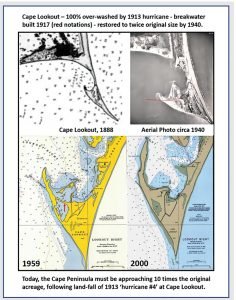By Gary L. Morgan —
I was intrigued to read the published letter to the editor, “More Needs To Be Done for Tangier” (Oct. 10, https://easternshorepost.com/2021/10/10/more-needs-to-be-done-for-tangier/)
More than 80% of known land subsidence (sinking) in the U.S. is a result of groundwater pumping. Deep artesian wells drilled through rock to intersect underground aquifers generally have layers of solid and granular materials above and below under enormous pressures. As increasing volumes of water are removed, sinking occurs due to compaction.
Over the past century, the Hampton Roads area of the Chesapeake Bay region has experienced one of the highest rates of relative sea level rise on the Atlantic coast. A study published in Geophysical Research Letters (2016) outlines a hot spot from Delaware and Maryland into northern North Carolina where the effects of groundwater pumping have contributed to the sinking of the underlying landmass. (https://doi.org/10.1002/2016GL068015)
This rate of relative sea level rise results largely from a combination of land subsidence, which has long been accepted by scientists, and possibly rising seas due to melting polar ice. Annapolis, Md., suffers this identical consequence with frequent high tide flooding of the downtown waterfront. (https://www.capitalgazette.com/weather/ac-cn-dock-flooding-0920-story.html)
There is currently no long-range plan for saving Tangier, although the plan outlined in Scientific Reports represented an excellent objective (https://www.nature.com/articles/srep17890). Having worked in government as a scientist, and in collaboration with National Laboratories, I believe the continual denial of land subsistence (sinking) is counter-productive and possibly a significant funding impediment.
The project to save Poplar Island — a Chesapeake Bay island in Talbot County, Md. — is projected to cost an estimated $1.4 billion at completion in 2029. Spoils from dredging at the Port of Baltimore are placed on the island as fill. The port contributes $1.9 billion annually in business to the state’s economy, thus the true cost to save Poplar Island is reimbursed repeatedly through direct economic benefit to the port.
The economic benefit to saving Tangier presents a huge challenge, thus collaborative efforts with all of the economic, political, Virginia State University, and federal scientific and engineering communities are necessary if there is any hope to obtain very near politically impossible necessary funding. The current strategy of denial is likely a significant liability.
A Draft Plan to Save Tangier Island
- Disputing science is counter-productive. Land surface subsistence (sinking) is proven accepted scientific observation. Slowly rising sea levels are also indisputable. The volume displacement of sea water actually rises with increasing global temperatures.
- Any rise in sea levels and/or decrease in elevation due to land subsistence promotes shoreline erosion. Erosion is not a cause; erosion is a result. As a scientist who has worked to obtain and award government funding, I believe scientific denial impairs necessary collaborative relationships.
- The journal article in Scientific Reports – “Climate Change and the Evolution and Fate of the Tangier Islands of Chesapeake Bay” (https://www.nature.com/articles/srep17890) proposes an excellent starting point for restoration. Within the proposal, estimates for initial construction of breakwaters, beaches, dunes and ridges are approximately $20–$30 million dollars. Acknowledging this to be an extraordinary funding challenge, the installation of breakwaters is likely the only viable option to save Tangier.
- Tangier would be wise to stop advocating for sea walls and seek funding options with proven mitigation strategies. Army Corps of Engineers marine biologist David Schulte insists sea walls will not save Tangier. He’s correct. Sea walls simply redirect erosion elsewhere; they do nothing to promote accretion (build-up) of stable new reinforced beachfront. Breakwaters provide accretion benefits that sea walls cannot.
- See, for example, the highly successful breakwater installation following hurricane storm-surge overwash of Cape Lookout in 1913. Today, Cape Lookout has nearly 10 times the original landmass before destruction, the result of a single breakwater. More importantly, virtually all of the accretion of new reinforced beachfront occurred in waters previously 35 to 40 feet deep.

Source: Composite of images from the Historical Chart Project, https://historicalcharts.noaa.gov - All efforts for funding not supported by the Army Corps of Engineers in cooperation with the scientific community are unlikely to achieve consideration.
- To obtain funding from Virginia and the federal government, Tangier must learn to speak the language in terms of economic benefit or loss. For example, from the study mentioned in point No. 3, above) – the economic benefit of Tangier’s crabbing industry is $3.9 million per year, and the value of lost ecosystems (wetlands) by 2063 another $1.75 million per year, and the loss of Uppards at $3 million. Add to this, the economic value of the winter oyster fishery, tourism, and the local economy. A qualified consultant could probably justify $15 million or more in economic loss.
In closing, I am not taking exception with the words of former Tangier Mayor, Gerald Wheatley. Instead, I thought it may prove beneficial for those “fighting the fight” to appreciate how they may be viewed by outsiders. While I valued my time on Tangier during my youth, I am truly an outsider.
Dealing with the government is a monumental challenge; I know this as both an insider and an outsider. The best advice I can provide is (1) pick your battles wisely, (2) remain laser-focused on “big picture” objectives, and (3) build relationships; the default response from bureaucracy is usually “No.” Dealing with the government is a stepwise endeavor that requires the continual nurturing of critical relationships to achieve long-term success.
Gary Morgan began his career as a research associate at the Johns Hopkins University, department of physics. He served as senior research scientist at Pfizer Medical Systems, and director of engineering and product development at Pacific Scientific. Gary is the award recipient of a government-funded Small Business Technology Transfer (STTR) with Los Alamos National Laboratories, and retired Department of Defense Science and Technology program manager for research.



